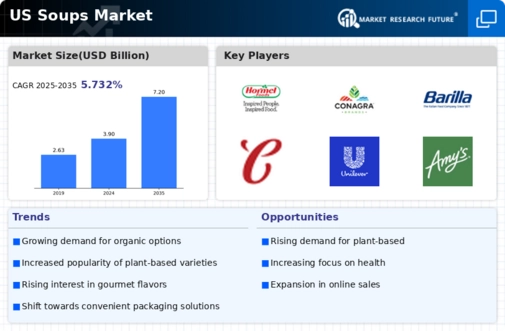Expansion of E-commerce Channels
The rise of e-commerce has significantly impacted the soups market, providing consumers with greater access to a diverse range of products. Online shopping has become increasingly popular, particularly among younger demographics who value convenience and variety. In 2025, e-commerce is projected to account for approximately 30% of total soup sales in the US. This shift is prompting traditional retailers to enhance their online presence and adapt their distribution strategies. The soups market is leveraging digital platforms to reach consumers directly, offering subscription services and personalized recommendations. This trend not only facilitates easier access to products but also allows for targeted marketing efforts, potentially increasing customer engagement. As e-commerce continues to grow, the soups market is likely to benefit from enhanced visibility and sales opportunities.
Rising Demand for Plant-Based Soups
The soups market is experiencing a notable shift towards plant-based options, driven by increasing consumer awareness regarding health and sustainability. As more individuals adopt vegetarian and vegan diets, the demand for plant-based soups has surged. In 2025, plant-based soups are projected to account for approximately 25% of the total soups market in the US. This trend indicates a significant transformation in consumer preferences, as they seek nutritious and environmentally friendly alternatives. The soups market is responding by innovating and expanding their product lines to include a variety of plant-based ingredients, catering to this growing demographic. Furthermore, the rise of flexitarian diets, where consumers reduce meat consumption without fully eliminating it, further supports this trend, suggesting that the soups market will continue to evolve in alignment with these dietary shifts.
Growing Interest in Functional Foods
The concept of functional foods is gaining traction within the soups market, as consumers increasingly seek products that offer health benefits beyond basic nutrition. Soups fortified with vitamins, minerals, and probiotics are becoming more prevalent, appealing to health-conscious consumers. In 2025, it is estimated that functional soups will represent around 15% of the total soups market in the US. This trend reflects a broader consumer desire for foods that support overall well-being and specific health goals. The soups market is responding by developing innovative formulations that cater to these needs, such as soups designed to boost immunity or enhance digestive health. As awareness of functional foods continues to rise, the soups market is likely to see a sustained increase in demand for these specialized products.
Increased Focus on Clean Label Products
In recent years, there has been a marked increase in consumer preference for clean label products within the soups market. Shoppers are increasingly scrutinizing ingredient lists, favoring products that are free from artificial additives and preservatives. This trend is indicative of a broader movement towards transparency in food production. In 2025, it is estimated that around 60% of consumers in the US prioritize clean label attributes when purchasing soups. The soups market is adapting by reformulating existing products and launching new lines that emphasize natural ingredients. This shift not only aligns with consumer expectations but also enhances brand loyalty, as consumers are more likely to support companies that prioritize health and transparency. As a result, the soups market is likely to see sustained growth driven by this clean label trend.
Influence of Culinary Trends on Soup Varieties
Culinary trends are playing a pivotal role in shaping the offerings within the soups market. As consumers become more adventurous in their eating habits, there is a growing demand for unique and globally inspired flavors. In 2025, it is anticipated that ethnic and gourmet soups will account for approximately 20% of the total soups market in the US. This trend indicates a shift away from traditional flavors towards more diverse and innovative options. The soups market is capitalizing on this trend by introducing new varieties that reflect global cuisines, such as Thai, Indian, and Mediterranean flavors. This diversification not only attracts a broader consumer base but also enhances the overall appeal of the soups market, suggesting that culinary creativity will continue to drive product development.

















Leave a Comment